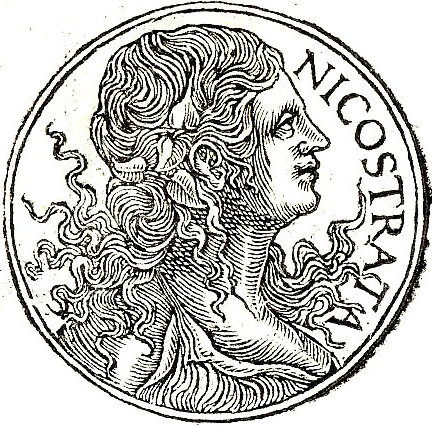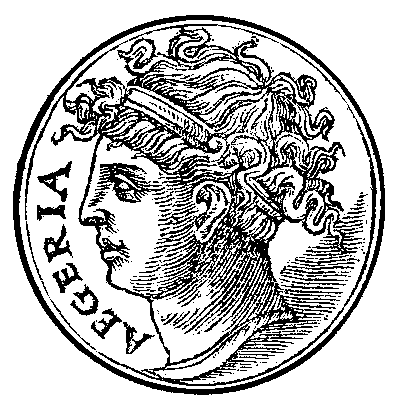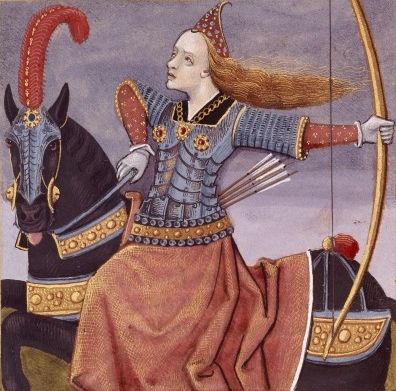|
Carmentis
In ancient Roman religion and myth, Carmenta was a goddess of childbirth and prophecy, associated with technological innovation as well as the protection of mothers and children and a patron of midwives. She was also said to have invented the Latin alphabet. Background The name ''Carmenta'' is derived from Latin ''carmen'', meaning a magic spell, oracle or song, and also the root of the English word ''charm''. Her original name was Nicostrate (, "victory-army"), but it was changed later to honor her renown for giving oracles (Latin singular: ''carmen''). She was the mother of Evander of Pallene (fathered by Hermes) and, along with other Greek followers, they founded the town of Pallantium which later was one of the sites of the start of Rome. Gaius Julius Hyginus (''Fab. 277'') mentions the legend that it was she who altered fifteen letters of the Greek alphabet to become the Latin alphabet which her son Evander introduced into Latium. Carmenta was one of the Camenae and the ... [...More Info...] [...Related Items...] OR: [Wikipedia] [Google] [Baidu] |
Camenae
In Roman mythology, the Camenae (; also ''Casmenae'', ''Camoenae'') were originally goddesses of childbirth, wells and fountains, and also prophetic deities. List of Camenae There were four Camenae: *Carmenta, or Carmentis * Egeria, or Ægeria, or Aegeria *Antevorta, or Porrima *Postverta, or Postvorta, or Prorsa The last two were sometimes specifically referred to as the Carmentae and in ancient times might have been two aspects of Carmenta rather than separate figures; in later times, however, they are distinct beings believed to protect women in labor. Carmenta was chief among the nymphs. Her festival day, the Carmentalia, featured water ritually drawn by Vestal Virgins from the spring outside the Porta Capena. The Camenae were later identified with the Greek Muses; in his translation of Homer's ''Odyssey'', Livius Andronicus rendered the Greek word ''Mousa'' as ''Camena'' and Horace refers to poetic inspiration as the "soft breath of the Greek Camena" (spiritum Graiae tenue ... [...More Info...] [...Related Items...] OR: [Wikipedia] [Google] [Baidu] |
Cimmerian Sibyl
Cimmerian Sibyl by Guercino. The Cimmerian Sibyl, by name Carmentis, was the prophetic priestess presiding over the Apollonian Oracle at Cimmerium in Italy, near Lake Avernus (i.e. Cumae). Background The word Sibyl comes (via Latin) from the ancient Greek word ''sibylla'', meaning prophetess. There were many sibyls in the ancient world (e.g. Samian, Cumaean), but the Cimmerian Sibyl was venerated by the pre-Hellenic native populations. The Cimmerian Sibyl may have been a doublet for the Cumaean since the designation Cimmerian refers to priestesses who lived underground near Lake Avernus. An oracular shrine dedicated to Apollo, as at Delphi, stood on the Acropolis of Cumae. An underground Roman road ran from the southeastern part of Cumae, through Mount Grillo to the shores of Lake Avernus. However, there are sources that distinguished the two sibyls such as those that noted it was the Cumaean and not the Cimmerian Sibyl who offered King Tarquin her book of propheci ... [...More Info...] [...Related Items...] OR: [Wikipedia] [Google] [Baidu] |
Hermes
Hermes (; grc-gre, wikt:Ἑρμῆς, Ἑρμῆς) is an Olympian deity in ancient Greek religion and Greek mythology, mythology. Hermes is considered the herald of the gods. He is also considered the protector of human heralds, travellers, thieves, merchants, and orators. He is able to move quickly and freely between the worlds of the mortal and the divine, aided by his winged sandals. Hermes plays the role of the psychopomp or "soul guide"—a conductor of souls into the Underworld, afterlife. In myth, Hermes functions as the emissary and messenger of the gods, and is often presented as the son of Zeus and Maia, the Pleiades (Greek mythology), Pleiad. Hermes is regarded as "the divine trickster," about which the ''Homeric Hymn, Homeric Hymn to Hermes'' offers the most well-known account. His attributes and symbols include the herma, the rooster, the tortoise, wallet, satchel or pouch, talaria (winged sandals), and winged helmet or simple petasos, as well as the palm tr ... [...More Info...] [...Related Items...] OR: [Wikipedia] [Google] [Baidu] |
Evander Of Pallantium
In Roman mythology, Evander (from Greek ''Εὔανδρος'' Euandros, "good man" or "strong man": an etymology used by poets to emphasize the hero's virtue) was a culture hero from Arcadia, Greece, who was said to have brought the Greek pantheon, laws, and alphabet to Italy, where he founded the city of Pallantium on the future site of Palatine Hill, Rome, sixty years before the Trojan War. He instituted the festival of the Lupercalia. Evander was deified after his death and an altar was constructed to him on the Aventine Hill. In addition, Strabo mentions a story that Rome was an Arcadian colony founded by Evander. Genealogy Dionysius of Halicarnassus writes that Evander was the son of Apollo and a local nymph of the Arcadians, called Themis. He also mentions that the writers of the early history of Rome called her, in their native language, Carmenta. Strabo writes that the Romans honour the mother of Evander, regarding her as one of the nymphs, and have renamed her ... [...More Info...] [...Related Items...] OR: [Wikipedia] [Google] [Baidu] |
Porta Carmentalis
The Porta Carmentalis was a double gate in the Servian Walls of ancient Rome. It was named for a nearby shrine to the goddess or nymph Carmenta, whose importance in early Roman religion is also indicated by the assignment of one of the fifteen '' flamines'' to her cult, and by the archaic festival in her honor, the Carmentalia. The shrine was to the right as one exited the gate. The gate's two arches seem to have been set at angles, and were known by separate names. It was unlucky to leave the city through the arch called Porta Scelerata ("Accursed Gate"), which was supposed to have been named for the military disaster at Cremera in 479 or 478 BC, since the 306 Fabii who died had departed through it. The Servian Walls, however, did not exist at that time. The accursed nature of the gate probably derives from the transport of corpses out of the city proper to funeral pyres on the Campus Martius. The family tomb of the Claudii was located outside the Porta Carmentalis. The other ... [...More Info...] [...Related Items...] OR: [Wikipedia] [Google] [Baidu] |
Childhood Goddesses
A child ( : children) is a human being between the stages of birth and puberty, or between the developmental period of infancy and puberty. The legal definition of ''child'' generally refers to a minor, otherwise known as a person younger than the age of majority. Children generally have fewer rights and responsibilities than adults. They are classed as unable to make serious decisions. ''Child'' may also describe a relationship with a parent (such as sons and daughters of any age) or, metaphorically, an authority figure, or signify group membership in a clan, tribe, or religion; it can also signify being strongly affected by a specific time, place, or circumstance, as in "a child of nature" or "a child of the Sixties." Biological, legal and social definitions In the biological sciences, a child is usually defined as a person between birth and puberty, or between the developmental period of infancy and puberty. Legally, the term ''child'' may refer to anyone below the ... [...More Info...] [...Related Items...] OR: [Wikipedia] [Google] [Baidu] |
Theodontius
Theodontius was the author of a now lost Latin work on mythology. He was extensively quoted in Giovanni Boccaccio's ''Genealogia Deorum Gentilium'', but is otherwise almost unknown. Boccaccio says that he knew Theodontius's work through the ''Collections'' of Paul of Perugia, which Paul's wife burnt after his death (''Genealogiae'' XV 6). In telling the legend of Bathyllus, however, Boccaccio complains that Theodontius was illegible except for Bathyllus's birth, from Phorcys and a marine monster (''Genealogiae'' X 7), so he may have seen some of Theodontius's own writings; sources disagree on this. Some authorities think Boccaccio invented him. Outside Boccaccio, there was a Theodontius, who wrote on the wars of Troy, and is quoted by Servius on ''Aeneid'', I, 28; and the fourteenth century author Domenico Bandini, who made an index for the ''Genealogiae'', calls him "''Teodontius Campanus diligens investigator poetici figmenti''". Carlo Landi argued in his 1930 monograph ''D ... [...More Info...] [...Related Items...] OR: [Wikipedia] [Google] [Baidu] |
Giovanni Boccaccio
Giovanni Boccaccio (, , ; 16 June 1313 – 21 December 1375) was an Italian writer, poet, correspondent of Petrarch, and an important Renaissance humanist. Born in the town of Certaldo, he became so well known as a writer that he was sometimes simply known as "the Certaldese" and one of the most important figures in the European literary panorama of the fourteenth century. Some scholars (including Vittore Branca) define him as the greatest European prose writer of his time, a versatile writer who amalgamated different literary trends and genres, making them converge in original works, thanks to a creative activity exercised under the banner of experimentalism. His most notable works are '' The Decameron'', a collection of short stories which in the following centuries was a determining element for the Italian literary tradition, especially after Pietro Bembo elevated the Boccaccian style to a model of Italian prose in the sixteenth century, and '' On Famous Women''. He ... [...More Info...] [...Related Items...] OR: [Wikipedia] [Google] [Baidu] |
Florence
Florence ( ; it, Firenze ) is a city in Central Italy and the capital city of the Tuscany Regions of Italy, region. It is the most populated city in Tuscany, with 383,083 inhabitants in 2016, and over 1,520,000 in its metropolitan area.Bilancio demografico anno 2013, datISTAT/ref> Florence was a centre of Middle Ages, medieval European trade and finance and one of the wealthiest cities of that era. It is considered by many academics to have been the birthplace of the Renaissance, becoming a major artistic, cultural, commercial, political, economic and financial center. During this time, Florence rose to a position of enormous influence in Italy, Europe, and beyond. Its turbulent political history includes periods of rule by the powerful House of Medici, Medici family and numerous religious and republican revolutions. From 1865 to 1871 the city served as the capital of the Kingdom of Italy (established in 1861). The Florentine dialect forms the base of Italian language, Stan ... [...More Info...] [...Related Items...] OR: [Wikipedia] [Google] [Baidu] |
De Mulieribus Claris
''De Mulieribus Claris'' or ''De Claris Mulieribus'' (Latin for "Concerning Famous Women") is a collection of biographies of historical and mythological women by the Florentine author Giovanni Boccaccio, composed in Latin prose in 1361–1362. It is notable as the first collection devoted exclusively to biographies of women in post-ancient Western literature. At the same time as he was writing ''On Famous Women'', Boccaccio also compiled a collection of biographies of famous men,'' De Casibus Virorum Illustrium'' (''On the Fates of Famous Men''). Purpose Boccaccio claimed to have written the 106 biographies for the posterity of the women who were considered renowned, whether good or bad. He believed that recounting the deeds of certain women who may have been wicked would be offset by the exhortations to virtue by the deeds of good women. He writes in his presentation of this combination of all types of women that he hoped it would encourage virtue and curb vice. Overview The ... [...More Info...] [...Related Items...] OR: [Wikipedia] [Google] [Baidu] |
Rome, Italy
, established_title = Founded , established_date = 753 BC , founder = King Romulus ( legendary) , image_map = Map of comune of Rome (metropolitan city of Capital Rome, region Lazio, Italy).svg , map_caption = The territory of the ''comune'' (''Roma Capitale'', in red) inside the Metropolitan City of Rome (''Città Metropolitana di Roma'', in yellow). The white spot in the centre is Vatican City. , pushpin_map = Italy#Europe , pushpin_map_caption = Location within Italy##Location within Europe , pushpin_relief = yes , coordinates = , coor_pinpoint = , subdivision_type = Country , subdivision_name = Italy , subdivision_type2 = Region , subdivision_name2 = Lazio , subdivision_type3 = Metropolitan city , subdivision_name3 = Rome Capital , government_footnotes= , government_type = Strong Mayor–Council , leader_title2 = Legislature , leader_name2 = Capitoline Assem ... [...More Info...] [...Related Items...] OR: [Wikipedia] [Google] [Baidu] |





_School_-_Boccaccio_(1313–1375)_(Giovanni_Boccaccio)_-_355512_-_National_Trust.jpg)

